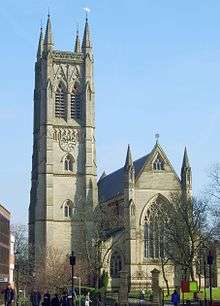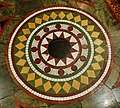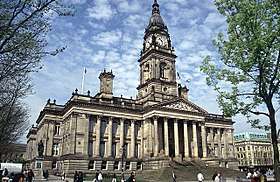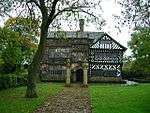St Peter's Church, Bolton
St Peter's Church, Bolton-le-Moors, commonly known as Bolton Parish Church, is a Church of England parish church in Bolton, Greater Manchester, England. The parish church, dedicated to St Peter, is an example of the Gothic Revival style. The church is recorded in the National Heritage List for England as a Grade II* listed building, having been designated in 1974.[1] St Peter's is an active parish church in the Diocese of Manchester and is part of the Bolton deanery and Bolton archdeaconry.[2]
| St Peter's Church | |
|---|---|
| The Parish Church of St Peter, Bolton-le-Moors | |
 St Peter's Church | |

| |
| 53.5794°N 2.4237°W | |
| Location | Bolton |
| Country | England |
| Denomination | Church of England |
| Churchmanship | Central Churchmanship |
| Website | boltonparishchurch.co.uk |
| History | |
| Status | Parish Church |
| Founded | Anglo-Saxon origin |
| Dedication | Saint Peter |
| Consecrated | 29 June 1871 |
| Architecture | |
| Functional status | Active |
| Heritage designation | Grade II* |
| Designated | 26 April 1974 |
| Architect(s) | Edward Paley |
| Style | Gothic Revival |
| Completed | 1871 |
| Construction cost | £45,000 |
| Specifications | |
| Length | 156 feet (48 m) |
| Width | 67 feet (20 m) |
| Height | Roof 82 feet (25 m) Tower 180 feet (55 m) |
| Materials | Longridge stone |
| Administration | |
| Parish | Bolton-le-Moors |
| Deanery | Bolton |
| Archdeaconry | Bolton |
| Diocese | Manchester |
| Province | York |
| Clergy | |
| Vicar(s) | Revd Canon Dr Chris Bracegirdle |
| Curate(s) |
|
| Laity | |
| Director of music | Michael Pain |
| Organist(s) | Michael Pain |
History
The church, on a hill overlooking the River Croal, is the fourth to be built on the site. Until the 1840s the ancient ecclesiastical parish of Bolton-le-Moors covered a large area and was divided into townships, some of which had chapels of ease.[3][4] The modern parish covers the town centre and its immediate surroundings.[5]
Demolition of the 15th-century church in 1866 revealed several pre-Norman stones under the tower, including a preaching cross in three pieces. Fragments of other crosses and stones from the 11th, 12th and 13th centuries, a sepulchral slab, stone coffin, and the remains of a 14th-century stone female figure, indicate that two earlier churches had existed on the same site, one Anglo Saxon and one Norman.[3]
Little is known of the first two buildings, but the squat, 15th-century church which replaced the Norman structure had an embattled west tower, a chancel, nave, north and south aisles and a south porch which was rebuilt in 1694. Its east window had seven lights. The Chetham and Bradford Chapels occupied the east end of the aisles on either side of the chancel. Galleries were added in the 18th century and the aisle walls were raised and windows inserted to light them. Though the church was modified over the years, the population of Bolton expanded rapidly during the Industrial Revolution and the church, in a poor state of repair, became too small and was demolished.[3] Fragments of stone and other artefacts from the first three buildings are displayed in the museum corner of the present church.[6]
The present church, built between 1867 and 1871, was designed by the Lancaster architect E. G. Paley. It cost £45,000 (equivalent to £4,220,000 in 2019),[7] and was paid for by Peter Ormrod, a local cotton spinner and banker, of Halliwell Hall.[8]
Structure
The church is 67 feet (20 m) wide, 156 feet (48 m) long, and 83 feet (25 m) high. Its tower is 180 feet (55 m) high, and is the highest church tower in the historic county of Lancashire.[9]
Exterior
The church, built in ashlar sandstone with slate roofs, has a nave with clerestory and north and south aisles, transepts, a chancel with a lady chapel and pipe organ chamber. On the south side of the south aisle is a gabled porch with a wrought-iron screen. The vestry, which was added later at its north east corner, is reminiscent of the chapter houses of pre-Reformation abbeys.[1]
The four-stage tower projects from the west end of the north aisle and has clasping buttresses at each corner which terminate in crocketted finials. There are two-light decorated, lancet windows in the second and third stages, and paired bell-chamber lights at the fourth stage. Its west door is in a moulded archway with polished granite shafts. The door, designed by Hubert Austin, retains its original ornate hammered ironwork door furniture.[1]
The church has a five-bay nave, divided by buttresses with lean-to aisles and a clerestory above. In each bay is a three-light decorated window with tracery. The clerestory has paired windows with ball flower decorations and gargoyles. There are traceried pinnacles at the east end of chancel. There is a seven-light east window in the chancel with lancet windows above it. The north transept has a seven-light window and there is a five-light decorated window in the south transept. The lady chapel to the east of the chancel has two two-light windows to south and a three-light east window.[1]
Fittings and furnishings
The chancel and west end of the nave have encaustic tiled floors by Minton. The octagonal wood panelled pulpit wraps round the northern crossing pier, it has stone base and a wrought iron rail to the stairs. The nave seating, canopied civic stalls and choir stalls are original.[1] Three misericords were saved from the 15th-century church.
Of the eight bells installed when the church opened, five were cast in 1699 by Henry Bagley of Ecton in Northamptonshire and three by Rudhall of Gloucester in 1806.[3] The old bells were replaced by the bells from Saviours Church on Deane Road in 1974. Five new trebles were recast from the old bells by John Taylor & Co and the tenor bell was retained and hung "dead" and is rung electrically when required. The tenor bell is inscribed, "I to the Chvrch the living call And to the grave doe svmmon all Henry Bagley made mee 1699".[10]
An organ built in 1795 was enlarged in 1852 and replaced in 1882 by a new one which reused some of the old pipes.[1][3] The three-manual organ built by A. G. Hill in 1882, in a case decorated with stylised flowers and angels, was rebuilt in 2008 by Principal Pipe Organs of York. The organ has almost 3,000 internal pipes, the largest 16 feet long and the smallest half an inch.[11][12]
Vicars of Bolton-le-Moors
The following is a list of the vicars since the Reformation:[3][13]
|
|
Directors of Music
- William Lonsdale c. 1809–25
- Witton Thomas c. 1825–40
- John Fawcett, BMus 1840–57
- John Aspinall 1857–64
- Joseph Varey 1865
- John H. L. Glover 1865–67
- Miss S. Warbreck 1867–69
- William Best 1869–89
- Walter J. Lancaster, BMus, FRCO, LRAM 1889–1947
- George Fisher, BMus, FRCO, LRAM 1947–52
- Arthur M. Stanier, LRAM, ARCO 1952–56
- P. A. S. Stevens, BSc, BMus 1957–58
- William Morgan, BA, FRCO 1959–86
- Kevin Morgan, BA, PhD, FRCO, LRAM 1986–96
- Martin Bussey, MA 1996–2000
- Stephen H. Carleston, MA, FRCO (Chm) 2000–09
- Michael J. Pain, MA, FRCO, LRAM, ARCM since 2009
Interior
 Main door
Main door Altar
Altar

 Stained glass window
Stained glass window Gravestone
Gravestone Floor tiles in the chancel
Floor tiles in the chancel Decorated organ pipes
Decorated organ pipes
See also
References
Citations
- Historic England, "Parish Church of St Peter, Bolton (1387979)", National Heritage List for England, retrieved 11 June 2012
- "Bolton Archdeanery", Manchester Diocese, retrieved 13 September 2010
- Farrer, William; Brownbill, J, eds. (1911), "The parish of Bolton-le-Moors", A History of the County of Lancaster: Volume 5, British History Online, pp. 235–243, retrieved 15 May 2013
- "Index Map to the Parish of Bolton", A History of the County of Lancaster: Volume 5, British History Online, pp. 235–243, 1911, retrieved 15 May 2013
- Bolton-le-Moors: St Peter (Parish Map). URL accessed 4 July 2016.
- "Church History", Bolton Parish Church, retrieved 15 May 2013
- UK Retail Price Index inflation figures are based on data from Clark, Gregory (2017), "The Annual RPI and Average Earnings for Britain, 1209 to Present (New Series)", MeasuringWorth, retrieved 2 February 2020
- Brandwood et al. 2012, p. 222
- Brandwood et al. 2012, p. 66
- "Bell Ringing", Bolton Parish Church, retrieved 15 May 2013
- "Bolton Parish Church Organ back to its former glory", The Bolton News, retrieved 3 August 2010
- "Music at Bolton Parish Church", Bolton Parish Church, retrieved 18 May 2013
- Life of the priest. Parish Magazine, June Issue 2008, page 6, retrieved 24 March 2009 Archived 18 November 2008 at the Wayback Machine
Bibliography
- Brandwood, Geoff; Austin, Tim; Hughes, John; Price, James (2012), The Architecture of Sharpe, Paley and Austin, English Heritage, ISBN 978-1-84802-049-8
External links
![]()

